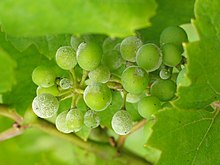Uncinula necator
| Uncinula necator | |
|---|---|
 |
|
| Scientific classification | |
| Kingdom: | Fungi |
| Division: | Ascomycota |
| Class: | Leotiomycetes |
| Order: | Erysiphales |
| Family: | Erysiphaceae |
| Genus: | Uncinula |
| Species: | U. necator |
| Binomial name | |
|
Uncinula necator (Schwein.) Burrill |
|
| Synonyms | |
|
Erysiphe necator Schwein. (1834) |
|
Erysiphe necator Schwein. (1834)
Uncinula necator (syn. Erysiphe necator) is a fungus that causes powdery mildew of grape. It is a common pathogen of Vitis species, including the wine grape, Vitis vinifera. The fungus is believed to have originated in North America. European varieties of Vitis vinifera are more or less susceptible to this fungus. Uncinula necator infects all green tissue on the grapevine, including leaves and young berries. It can cause crop loss and poor wine quality if untreated. The sexual stage of this pathogen requires free moisture to release ascospores from its cleistothecia in the spring. However, free moisture is not needed for secondary spread via conidia; high atmospheric humidity is sufficient. Its anamorph is called Oidium tuckeri.
It produces common odors such as 1-octen-3-one and (Z)-1,5-octadien-3-one.
This mildew can be treated with sulfur or fungicides; however resistance to several chemical classes such as Benomyl, the DMIs, and Strobilurins has developed. While synthetic fungicides are often recommended as applications around bloom, it is common to include sulfur in a tank mix to help with resistance management.
Powdery mildews are generally host-specific, and powdery mildew of grape is caused by a host-specific pathogen named Uncinula necator. Powdery mildew is a polycylic disease that thrives in warm, moist environments. Its symptoms are widely recognizable and include gray-white fungal growth on the surface of infected plants. A sulfur formulation, fungicides, and limiting the environmental factors that favor the growth of powdery mildews are all practices that can stall and/or halt its growth.
Powdery mildews are generally host-specific. Uncinula necator is the pathogen that causes powdery mildew on grape and linden. The most susceptible hosts of this pathogen are members of the species Vitis. The signs of powdery mildews are widely recognizable and easily identifiable. The majority of them can be found on the upper sides of the leaves; however, it can also infect the bottom sides, buds, flowers, young fruit, and young stems. A gray-white, dusty, fungal growth consisting of mycelia, conidia and conidiophores coat much of the infected plant. Cleistothecia, which are the overwintering structures, present themselves as tiny, spherical fruiting structures that go from white, to yellowish-brown to black in color, and are about the size of the head of a pin. Symptoms that occur as a result of the infection include necrosis, stunting, leaf curling, and a decrease in quality of the fruit produced.
...
Wikipedia
